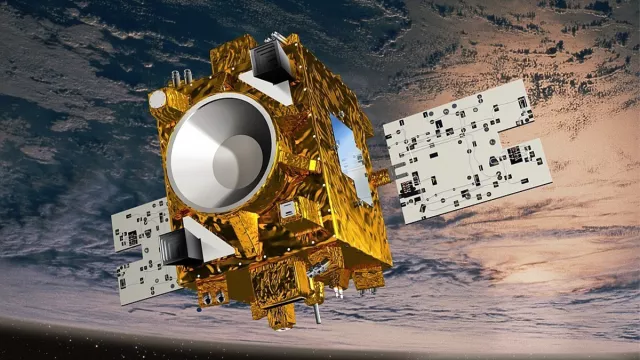In 2016, a CNES microsatellite tested the universality of free fall for the first time in space using an experiment 100 times more precise than anything on Earth.
Key information
| Mission | Verify the equivalence principle |
|---|---|
| Domain | Science |
| Launch date | 25 April 2016 |
| Partners | ONERA, CNRS, ESA, ZARM (Germany), PTB (Germany) |
| Where | Sun-synchronous circular orbit |
| Lifetime | 2 years |
| Status | Completed |
Key figures
- 100 times more precise than anything on Earth
- 300 kg: satellite mass
- 10-15 measurement precision
- 0.000 000 1°C: precision of estimated thermal fluctuations on sensor
Key milestones
- September 2022: Final results of equivalence principle measurements
- 17 October 2018: Satellite deorbited
- December 2017: First measurement of equivalence principle
- 25 April 2016: Launch of Microscope
- 8 December 2011: CNES gives go-ahead to build satellite
- 26 April 2004: CNES approves project
Project in brief
Back in the 17th century, Galileo conceived an experiment—but did not perform it—in which he dropped two objects of different composition and mass together from the top of the Tower of Pisa. In his theory, as the two objects hit the ground at exactly the same time, he deduced that in a vacuum all bodies fall at the same speed, whatever their mass and composition. This is what we call the universality of free fall or equality of gravitational and inertial mass, which Albert Einstein later stated as the equivalence principle and made it the basis of his theory of general relativity.
Although it has recently been verified with a degree of precision on the order of 10-13, this principle is nonetheless being pushed to its limits by new theories seeking to reconcile gravitation with fundamental nuclear and electromagnetic interactions, which predict that it could be violated at very weak levels. The Microscope satellite was designed to probe these limits further and test the principle with a precision on the order of 10-15. In space, it is possible to study the relative motion of two bodies in almost perfect and permanent free fall on an orbiting satellite, shielded from perturbations encountered on Earth (notably seismic perturbations), over the course of several months.
To achieve this, two concentric cylindrical test masses made of different materials—one titanium and one a platinum-rhodium alloy—are minutely controlled to maintain them motionless with respect to the satellite inside independent differential electrostatic accelerometers. If the equivalence principle is verified, the two masses are subjected to the same control acceleration. If different accelerations have to be applied, the principle is violated, an event that would shake the foundations of physics.
CNES’s role
The experiment was flown on a 300-kg microsatellite—heavier than a usual 100-150 kg microsatellite—built around CNES’s Myriade bus and equipped with cold-gas microthrusters capable of compensating for the tiniest trajectory perturbations that might otherwise skew its results. CNES provided 80% of funding for this mission, the rest being funded by ESA, ONERA, DLR and OCA. CNES was prime contractor in charge of satellite bus development, payload and bus integration, environmental testing, system development, technical and operational qualification, the launcher interface and launch campaign, in-orbit commissioning, and mission operations up to the end of the satellite’s life.
Contacts
Fundamental Physics subject matter expert
Martin Boutelier
E-mail: martin.boutelier at cnes.fr


